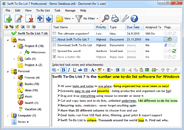Changing Your Perspective: From Primary Outcomes to the Big Picture
Getting Things Done is often touted as a revolutionary system, as it provides a significant departure from the productivity practices ingrained in the workplace. Obviously, overthrowing tools and methods that have been established as ‘the norm’ in offices around the country and world can be a hefty task, so it’s best to approach the task in manageable pieces. So where to begin? By changing your perspective.
Embracing the Big Picture
In the traditional work place, tasks are assigned as individual projects, completely out of the context of the larger overall project of which they are components. Assignments such as memos, spreadsheets and press releases are typically presented as existing in a vacuum, just one project afloat in a sea of unrelated work. And while this may seem to make work more manageable – you only have to think about the page in front of you – it’s actually doing you a disservice. One given document is merely an ingredient in the recipe that your company uses to present a finished product, so it should be treated as such.
As GTD author David Allen notes, “focusing on primary outcomes and values is a critical exercise,” but to be successful, you “must incorporate the results of big-picture thinking as well as the smallest of open details.”
In other words, you need to keep the overarching goals of your company (or business) in mind when you perform each task. By considering what place your assignment has in the larger scope of the project, you can refine your task and focus on what you need to do and what will be accomplished by other components of the project performed by your coworkers.
Big-Picture Benefits
This big-picture mindset can also take pressure off of you and open you up to more stress-free productivity. Altering your perspective – from seeing your task as the end-all, be-all to seeing it as a component in the scope of a larger project – can help alleviate anxiety and bring a feeling of teamwork into even your individual projects. The mindset can aid in promoting collaboration, which facilitates improved productivity and enhanced consistency with end products.
Collaboration is a breeze with Swift To-Do List 7, as you can assign tasks to others, email tasks to others, use notes to capture input from others, and utilize attachments to attach files (such as others’ work product) to tasks on your list. Since version 7.32, you can even create tasks from emails. Swift To-Do List 7 will also soon have full-blown online synchronization and collaboration feature (currently in beta).
From Outcomes to Inputs
But changing your perspective from focusing on small tasks in a vacuum to seeing them as part of the big picture can also work in terms of your own personal workflow. To help you make this transition, it may be helpful to adopt the vocabulary Allen uses in his book. The author classifies tasks as ‘inputs,’ which demonstrates the idea that your projects are means to an end, namely the company’s overall output. Your inputs are all interrelated and support overall project goals; this can be visualized easily with Swift To-Do List 7’s to-do list tree.
If that conceptualization doesn’t help, try a favorite of mine – consider your projects as ingredients in the overall recipe of your workflow.
Chocolate Chip Cookies
The big-picture perspective is crucial because it promotes prioritizing in your workflow. For example, if you’re making chocolate chip cookies (trust me here, I have a lot of experience), some ingredients, such as flour and sugar, are more important than others, such as vanilla extract or chocolate chips. Thus, you need to dedicate more resources to the tasks that represent your flour and sugar, because if you concentrate too much on securing chocolate chips, you may not have dough in which to incorporate them.
Perspective-Promoting Tools
By using Swift To-Do List 7’s filtering feature and ability to view all tasks at once, you can more easily assess the big picture for a given span of time; the feature allows you to view tasks due only in certain time ranges. Additionally, you can assign priorities to each task and sort the list by priority, due date, task type or name for proper perspective. You can even sort the list by multiple columns at once (eg. by Priority first, and by Due Date second).
Often, your mindset can determine your overall productivity. And while it can be tempted to imagine every project as a massively important event, you should remember that completion of an input task is merely a primary outcome, a component of the big picture. This realization will help prevent you from doing overlapping work on multiple tasks and increasing your workload inadvertently.
Seeing your tasks in perspective as part of your Swift To-Do List can alleviate the anxiety associated with getting weighed down in the details of individual projects. GTD guru Allen suggests that a combination of a calendar, to-do list and priority coding are more effective in combination than when used individually, as you may still be susceptible to distraction and lack of appropriate focus. Thankfully, Swift To-Do List 7 incorporates these features and more into one convenient, streamlined piece of software.
Post by Brian J. Willet






[...] Managing actions gives you a clear plan of attack, a manageable group of goals and an improved perspective. And, because breaking things down as far as possible helps make things easier, we’re going to [...]